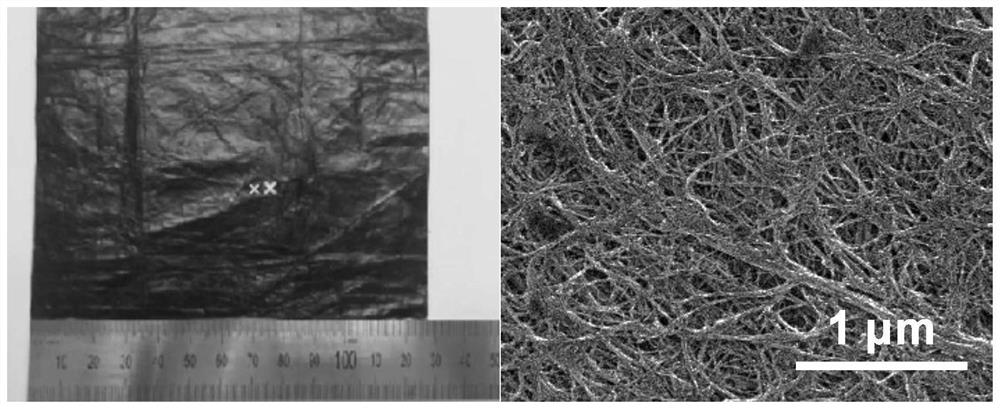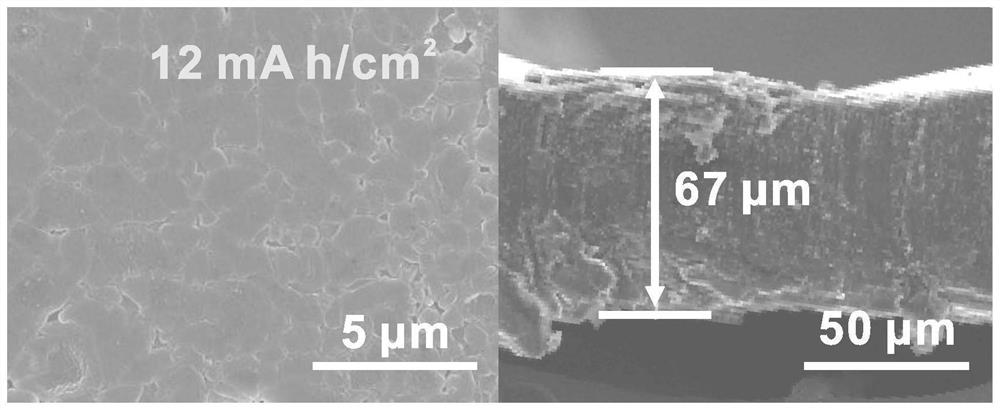A three-dimensional current collector, metal lithium negative electrode and primary/secondary battery for primary/secondary battery lithium metal negative electrode
A secondary battery and metal lithium technology, which is applied to the electrodes of primary batteries, battery electrodes, lithium batteries, etc., can solve the problems of damage to the specific capacity performance of composite electrodes, side reactions, poor conductivity and wettability, etc., and achieve good fast charging and discharging high capacity, high capacity charge/discharge, and high cycle stability
- Summary
- Abstract
- Description
- Claims
- Application Information
AI Technical Summary
Problems solved by technology
Method used
Image
Examples
preparation example Construction
[0051] The present invention also provides a method for preparing the metal lithium negative electrode of the above-mentioned primary / secondary battery, comprising the following steps:
[0052] After the above three-dimensional current collector is oxidized in a strong oxidant, it is immersed in molten metal lithium to obtain a metal lithium negative electrode.
[0053] In the present invention, the strong oxidant is selected from a mixture of dilute sulfuric acid and potassium permanganate, a mixture of concentrated sulfuric acid and concentrated nitric acid, a mixture of concentrated sulfuric acid and potassium permanganate, a mixture of concentrated sulfuric acid and potassium dichromate, or Two or more of the above mixtures.
[0054] The concentration of the dilute sulfuric acid is 1-3M, the concentrated sulfuric acid is concentrated sulfuric acid with a mass percentage ≥ 70%, and the concentrated nitric acid is nitric acid with a mass percentage of 90%-97.5%;
[0055] Th...
Embodiment 1
[0075] 1. Preparation and testing of lithium@carbon tube paper metal negative electrode by electrodeposition method
[0076] Punch the carbon tube paper finished product (thickness 5~6 μm, purchased from Suzhou Jiedi Nano Co., Ltd.) with a die tool with a diameter of 10 mm, see figure 1 , figure 1 It is the optical photo (left) and the scanning electron micrograph (right) of the carbon tube paper in Example 1, and a disc with a diameter of 10 mm was obtained. Submerge the disc in a mixed solution of ethanol and concentrated hydrochloric acid with a volume ratio of 10:1, and soak at room temperature for 6 hours to remove impurities such as surface oil and catalyst. The soaked wafers were cleaned twice in a mixed solution of deionized water and ethanol with a volume ratio of 2:1.
[0077] The cleaned carbon tube paper disc is used as the positive electrode, and the lithium sheet is used as the negative electrode to assemble a two-electrode button battery. The electrolyte is 1...
Embodiment 2
[0083] Cut 4cm 2 Carbon tube paper (thickness 5.5±0.5μm, purchased from Suzhou Jiedi Nano Co., Ltd.) was immersed in 4M concentrated sulfuric acid, and then 1g of potassium permanganate was added, stirred and heated in a water bath at 80°C for 6h. The reaction is complete when brownish yellow appears on the side wall of the vessel. Take out the modified carbon tube paper and rinse it with deionized water for 15s, and then soak it in the solution of ethanol and water with a volume ratio of 1:1 for 2h twice to complete the cleaning. It was then dried in an air-atmosphere oven at 60° C. for 6 h.
[0084] The finished modified carbon tube paper is still stamped as Put the wafer into a glove box with an argon atmosphere, heat the lithium slice to 260°C, and the lithium slice will melt into a bright silver liquid. One end of the carbon tube paper is immersed in molten lithium, and the molten lithium reacts with the surface functional groups of the modified carbon tubes to lithia...
PUM
| Property | Measurement | Unit |
|---|---|---|
| thickness | aaaaa | aaaaa |
| specific surface area | aaaaa | aaaaa |
| pore size | aaaaa | aaaaa |
Abstract
Description
Claims
Application Information
 Login to View More
Login to View More - R&D
- Intellectual Property
- Life Sciences
- Materials
- Tech Scout
- Unparalleled Data Quality
- Higher Quality Content
- 60% Fewer Hallucinations
Browse by: Latest US Patents, China's latest patents, Technical Efficacy Thesaurus, Application Domain, Technology Topic, Popular Technical Reports.
© 2025 PatSnap. All rights reserved.Legal|Privacy policy|Modern Slavery Act Transparency Statement|Sitemap|About US| Contact US: help@patsnap.com



